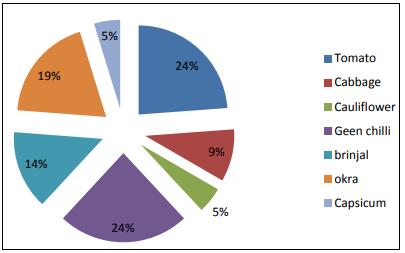Pesticide Residues in Vegetable and Fruits
Keywords:
Pesticide residues, vegetables, fruitsAbstract
Vegetable samples of brinjal, okra, green chilli, cabbage, cauliflower, tomato and capsicum from farmers'; field, Fruit samples like Banana, Pomegranate, Sweet Orange, Guava, and Grapes were collected from Market in Indore and were tested for the presence of organochlorine (OC), organophosphorus (OP) and synthetic parathyroid (SP) compounds using a gas chromatograph equipped with electron capture and Thermo sensitive detectors.Of the samples tested, 36.60 % were found to have pesticide residues. Among the OC compounds, α-endosulfan, β-endosulfan, were detected in 3.33 % of the samples with residues. These were taken from Cabbage and Brinjal samples. SP compound residues such deltamethrin were detected in 1.66 % of the samples with residues.OP compound residues such as chlorpyrifos, profenofos, ethion, dimethoate, Malathion, Quinalphos and methyl parathion were found in 22 % of the samples with residues, which were taken from all vegetable and fruit samples.15.3 % were found to contain residues exceeding the prescribed maximum residue limit. The average pesticide residue content across all the vegetable samples was 0.03 ppm, with values ranging from 0.03 to 1.18 ppm. Multiple residues of more than one compound were detected in 13.33 % of samples containing residues.
References
Adeyeye, A., & Osibanjo, O. (1999). Residues of organochlorine pesticides in fruits, vegetables and tubers from Nigerian markets. Science of the Total Environment, 231, 227–233.
Agnihotri, N. P. (1999). Pesticide, safety evaluation and monitoring. All India co-ordinated research project on pesticide residues (pp. 119–146). New Delhi: Division of Agricultural Chemicals, Indian Agricultural Research Institute.
Amoah, P., Drechsel, P., Abaidoo, R. C., & Ntow, W. J. (2006). Pesticide and pathogen contamination of vegetables in Ghana's urban markets. Archives of Environmental Contamination and Toxicology, 50, 1–6.
Anastassiades, M., Lehotay, S. J., Stajnbaher, D., &Schenck, F. J. (2003). Fast and easy multiresidue method employing acetonitrile extraction/partitioning and “dispersive solidphase extraction” for the determination of pesticide residues in produce. The Journal of AOAC International, 86,412–431.
Andaman and Nicobar Administration. (2009). Statistics book, Directorate of statistics. Port Blair: Andaman and Nicobar Administration.
Bempah, C. K., Kwofie, A. B., Enimil, E., Blewu, B., &Martey, G. A. (2012). Residues of organochlorine pesticides in vegetables marketed in Greater Accra region of Ghana. Food Control, 25, 537–542.
Bhanti, M., &Taneja, A. (2005). Monitoring of organochlorine pesticide residues in summer and winter vegetables from Agra, India—a case study. Environmental Monitoring and Assessment, 10, 341–346.
Bhanti, M., &Taneja, A. (2007). Contamination of vegetables of different seasons with organophosphorus pesticides and related health risk assessment in northern India. Chemosphere, 69, 63–68.
Bhattacharyya, A., Barik, S. R., &Ganguly, P. (2009). New pesticide molecules, formulation technology and uses: present status and future challenges. The Journal of Plant Protection Sciences, 1(1), 9–15.
Charan, P. D., Ali, S. F., Yati, K., & Sharma, K. C. (2010). Monitoring of pesticide residues in farmgate vegetables of central Aravalli region of western India. American-Eurasian Journal of Agricultural & Environmental Science, 7 (3), 255–258.
Chen, C., Yongzhong, Q., Qiong, C., Chuanjiang, T., Chuanyong, L., & Yun, L. (2011). Evaluation of pesticide residues in fruits and vegetable from Xiamen, China. Food Control, 22 (7), 1114–1120.
Chowdhury, M. T. I., Razzaque, M. A., & Khan, M. S. I. (2011). Chlorinated pesticide residue status in tomato, potato and carrot. Journal of Experimental Sciences, 2(1), 1–5.
Hjorth, K., Johansen, K., Holen, B., Andersson, A., Christensen, H. B., Siivinen, K., &Toome, M. (2011). Pesticide residues in fruits and vegetables from South America—a Nordic project. Food Control, 22(11), 1701–1706.
PFA. (1954). Prevention of Food Adulteration Act, 1954. Act.No. 37 with Prevention of Food Adulteration Rules, 1955 and Notification and Commodity Index. Lucknow: Eastern Book.
Igbedioh, S. O. (1991). Effects of agricultural pesticides on humans, animals and higher plants in developing countries. Archives of Environmental Health, 46, 218.
Kalra, R. L., &Chawla, R. P. (1985). Pesticidal contamination in foods in the year 2000 AD. Proceedings of Indian National Science Academy, B52, 188–204.
Kumari, B., Kumar, R., Madan, V. K., Singh, R., Singh, J., &Kathpal, T. S. (2003). Monitoring of pesticidal contamination in winter vegetables from Hisar, Haryana. Environmental Monitoring and Assessment, 87, 311–318.
Kumari, B., Madan, V. K., Singh, J., Singh, S., &Kathpal, T. S.(2004). Monitoring of pesticidal contamination of farmgate vegetables from Hisar. Environmental Monitoring and Assessment, 90, 65–71.
Lozowicka, B., Jankowska, M., & Kaczynski, P. (2012). Pesticide residues in Brassica vegetables and exposure assessment of consumers. Food Control, 25, 561–575.
Mandal, K., & Singh, B. (2010). Magnitude and frequency of pesticide residues in farmgate samples of cauliflower in Punjab, India. Bulletin of Environmental Contamination and Toxicology, 85(4), 423–426.
Mathur, S. C. (1999). Future of Indian pesticides industry in next millennium. Pesticide Information, XXIV, 4, 9–23
Mukherjee, I. (2003). Pesticides residues in vegetables in and around Delhi. Environmental Monitoring and Assessment,86, 265–271.
Nishina, T., Kien, C. N., Noi, N. V., Ngoc, H. M., Kim, C. S., Tanaka, S., & Iwasaki, K. (2010). Pesticide residues in soils, sediments and vegetables in the Red River Delta, northern Vietnam. Environmental Monitoring and Assessment,169, 285–297.
Singh, D.P. (2001). Pesticides pollution on veterinary public health and food safety in India. In: Livestock Community and Environment. Proceedings of the 10th Conference of the Association of Institutions for Tropical Veterinary Medicine, Copenhagen, Denmark
Singh, S. P., &Kiran Singh, N. K. (2006). Pesticide residues in farmgate vegetable samples in Bihar. Pest Management in Horticultural Ecosystems, 12(2), 152–155.
Waliszevski, S. M., PardioSedus, V. T., &Waliszevski, K. N. (1996). Detection of some organochlorine pesticides in cow's milk. Food Additives and Contaminants, 13, 231–235.

Downloads
Published
How to Cite
Issue
Section
License

This work is licensed under a Creative Commons Attribution 4.0 International License.
Authors contributing to this journal agree to publish their articles under the Creative Commons Attribution 4.0 International License, allowing third parties to share their work (copy, distribute, transmit) and to adapt it, under the condition that the authors are given credit and that in the event of reuse or distribution, the terms of this license are made clear.





